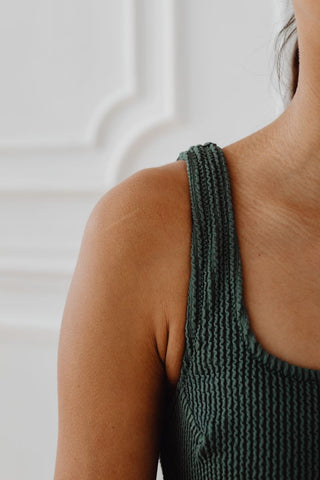(Psst…none of this is medical advice–just a word to the wise.)
There’s been a lot of hype around this fat-soluble vitamin lately. Understandably so.
It supports every system in your body.
But the main reason we love vitamin E is how it can reverse fat oxidation in your tissues– the real beef we have with PUFAs.
This antioxidant superpower calms stress in the body and literally pumps the breaks on aging.
True story.
Let’s dive into why it works and how to harness these metabolic benefits through diet and nourishing skincare.
How does Vitamin E protect against PUFA oxidation?
PUFAs are everywhere these days.
In our cooking oils, coffee creamers, makeup products, and even body lotions. The issue with using these fats in our everyday lives is they’re highly susceptible to oxidation.
And when an unsaturated fatty acid oxidizes in the body, it starts hunting for other fatty acids to desaturate and oxidize.
A domino effect that can elevate stress and lead to free radical damage in the cells. (1)
Some symptoms of oxidative stress are:
- Metabolic problems
- Unexplained tiredness and fatigue
- More body fat
- Wrinkling of the skin
- Liver and age spots
- Increased inflammation
- Greying hair
- Brain fog
- Muscle and joint pain
But one of the main benefits of vitamin E is it breaks this damaging cycle.
It generously donates electrons to satisfy the otherwise rampaging free radicals.
But this sacrificial vitamin is more than just an antioxidant. It also plays a role in “saturating” unsaturated fatty acids in the body. (2)
No wonder it often accompanies polyunsaturated fats in nature. It’s in almost every plant and animal that contains high levels of PUFAs.
But not so fast.
This doesn’t mean we should use seed oils without a second thought.
Like most things in life, it’s not that simple.
Though vitamin E is highly protective against the effects of PUFAs, these fatty acids have a much longer half-life.
This means the vitamin E in a food or product will likely be used up and out of your system long before the PUFAs. Especially since many of these fatty acids are consumed as industrial seed oils that lose some vitamin E in processing. (3)
The magic happens when we become, for lack of a better word, “deficient” in these types of fats while upping vitamin E.
Balancing this ratio allows vitamin E to really get to work repairing and protecting your cells.
Metabolic health benefits of vitamin E:
- Increased cellular energy production (fiery metabolism)
- Protection against iron accumulation
- Lower levels of inflammation
- Fertility support through boosted mid-luteal progesterone production and estrogen detoxification (4)
- Helps cells use vitamin A better for a stronger immune system and a healthier gut
Awesome.
So now you may be wondering how we can experience the benefits of vitamin E without all the PUFAs. Just keep scrolling.
How to get more vitamin E
Since the body doesn’t make it, we must get it from our food or skincare.
Here are some of our favorite natural sources of vitamin E that are also rich in saturated fatty acids.
- Eggs
- Jojoba oil
- Mango butter
- Butter
- Tallow (grassfed tallow contains almost four times the amount of vitamin E than grainfed tallow) (5)
- Liver
- Cacao butter
- Grains
- Leafy greens
Can vitamin E be absorbed through the skin?
Oh yeah.
When applied to the skin, vitamin E is easily absorbed and used locally, as well as in other areas of the body. (6)
Our skin cells love this nutrient, so a lot of it is stored in the sebaceous glands, where it moisturizes and protects.
One of the many reasons we use tallow, cacao butter, mango butter, and jojoba oil in our products.
Fatskn Face is a blend of
- Grassfed and grassfinished suet tallow
- Olive squalane oil (also a decent source of E)
- Mango butter
- Raw (unrefined) cacao butter
Fatskn Whipped Body Butter combines 3 simple, vitamin-rich ingredients
- Grassfed + grassfinished suet tallow
- Organic jojoba oil
- Raw (unrefined) cacao butter
What does vitamin E do for the skin? (why you’re really here)
Named the “beauty vitamin” for its nourishing effects on the skin, it does a lot.
Vitamin E helps strengthen the skin barrier and, as you already know, halts free radical damage.
This curbs the harmful (and aging) effects of our environment and the sun.
Benefits of vitamin E for the skin:
Conditions like psoriasis and dermatitis may disrupt the skin's structure and moisture content resulting in dry, flaky skin. Topical vitamin E can strengthen and repair the moisture barrier for smoother, healthier skin.
Vitamin E has anti-inflammatory properties that can bring down redness, itch, and swelling of the skin.
Not only does it fight UV-induced free radicals, but it’s been shown to have UV absorptive properties that aid in photoprotection. Talk about being proactive!
Dryness is caused by water loss in the top layer of the skin. Vitamin E helps to nourish skin cells so they naturally hold onto more moisture.
Vitamin E prevents and repairs roughness and skin-colored bumps caused by cellular oxidation. Leaving behind a smoother, more radiant complexion.
The moisturizing effects of vitamin E plump the skin, minimizing the appearance of wrinkles.
Vitamin E is a key player in making collagen which strengthens the skin and improves elasticity.
Whether hormone-induced or a bad breakout is to blame, vitamin E boosts cell turnover for diminished scars and dark spots. (8)
Unfortunately, our stores of this beautifying vitamin inevitably decrease with age.
Leaving the skin drier and more prone to oxidation as years pass.
Conventional anti-aging treatments and wrinkle creams try to harness the power of vitamin E– but they often fall short.
These products are usually loaded with hormone-disrupting chemicals and unstable PUFAs. Round and round we go.
Instead of settling for subpar strategies, we decided to make skincare the way nature intended.
Fatskn creams and balms use whole-food, vitamin-rich saturated fats that work with your skin to moisturize, protect, and heal.
The result?
Soft, glowy, youthful skin– even as you age.
As always, while we hope to be a no-nonsense resource, we encourage you to do your own research to find the healthiest options for you and your family.
References:
- Kumar, K. (2021, November 8). What Does Oxidative Stress Mean? Free Radical Damage. MedicineNet; MedicineNet. https://www.medicinenet.com/what_does_oxidative_stress_mean/article.htm
- Peat, R. (n.d.-c). Vitamin E: Estrogen antagonist, energy promoter, and anti-inflammatory. Raypeat.com. Retrieved March 13, 2023, from https://raypeat.com/articles/articles/vitamin-e.shtml
- Pendergrass Lsn, R. (n.d.). Nutrition and Immunity 4. https://www.vanderbilt.edu/olli/class-materials/Nutrition_Immunity_Spr21_Session4.pdf
- Mumford SL, Browne RW, Schliep KC, Schmelzer J, Plowden TC, Michels KA, Sjaarda LA, Zarek SM, Perkins NJ, Messer LC, Radin RG, Wactawski-Wende J, Schisterman EF. Serum Antioxidants Are Associated with Serum Reproductive Hormones and Ovulation among Healthy Women. J Nutr. 2016 Jan;146(1):98-106. doi: 10.3945/jn.115.217620. Epub 2015 Nov 18. PMID: 26581679; PMCID: PMC4700980. https://www.ncbi.nlm.nih.gov/pmc/articles/PMC4700980/
- Daley CA, Abbott A, Doyle PS, Nader GA, Larson S. A review of fatty acid profiles and antioxidant content in grass-fed and grain-fed beef. Nutr J. 2010 Mar 10;9:10. doi: 10.1186/1475-2891-9-10. PMID: 20219103; PMCID: PMC2846864. https://www.ncbi.nlm.nih.gov/pmc/articles/PMC2846864/
- Trevithick JR, Mitton KP. Uptake of vitamin E succinate by the skin, conversion to free vitamin E, and transport to internal organs. Biochem Mol Biol Int. 1999 Mar;47(3):509-18. doi: 10.1080/15216549900201543. PMID: 10204088. https://pubmed.ncbi.nlm.nih.gov/10204088/#:~:text=After%2024%20hr%2C%20up%20to,was%20hydrolysed%20to%20free%20tocopherol.
- Shaikh, J. (2021, May 14). What Is Vitamin E Oil Good For? 20 Health and Diseases Benefits. MedicineNet. https://www.medicinenet.com/what_is_vitamin_e_oil_good_for/article.htm
- Burke KE, Clive J, Combs GF Jr, Commisso J, Keen CL, Nakamura RM. Effects of topical and oral vitamin E on pigmentation and skin cancer induced by ultraviolet irradiation in Skh:2 hairless mice. Nutr Cancer. 2000;38(1):87-97. doi: 10.1207/S15327914NC381_13. PMID: 11341050. https://pubmed.ncbi.nlm.nih.gov/11341050/


